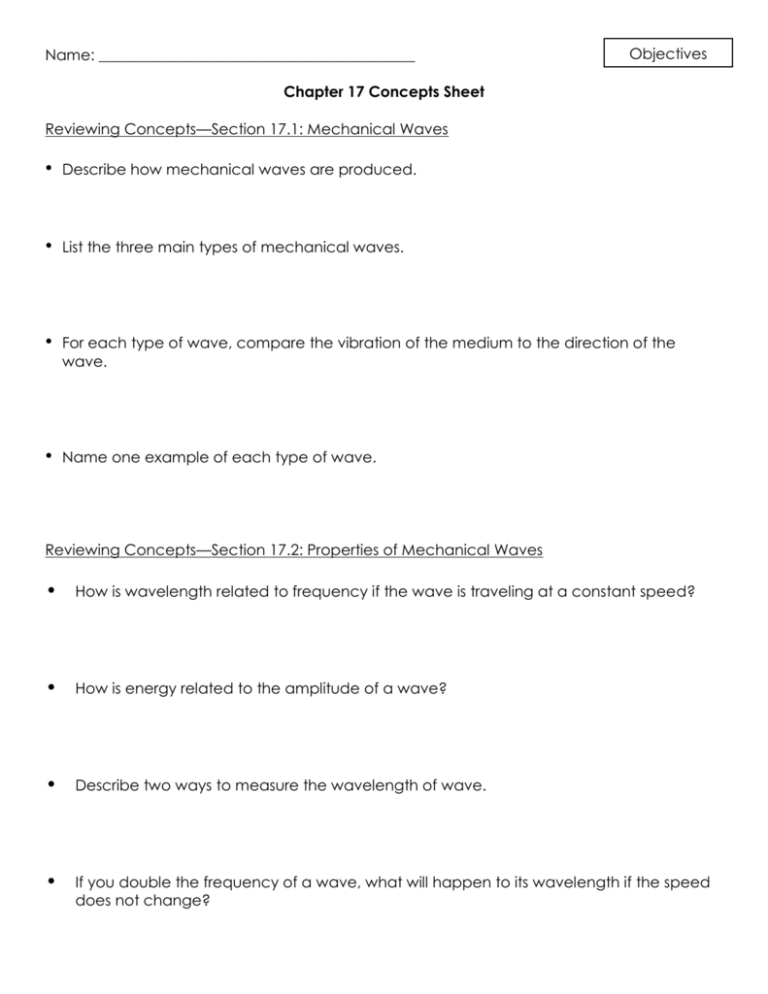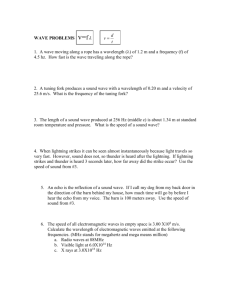Chapter 17 Worksheet Packet-
advertisement

Name: __________________________________________ Objectives Chapter 17 Concepts Sheet Reviewing Concepts—Section 17.1: Mechanical Waves • Describe how mechanical waves are produced. • List the three main types of mechanical waves. • For each type of wave, compare the vibration of the medium to the direction of the wave. • Name one example of each type of wave. Reviewing Concepts—Section 17.2: Properties of Mechanical Waves • How is wavelength related to frequency if the wave is traveling at a constant speed? • How is energy related to the amplitude of a wave? • Describe two ways to measure the wavelength of wave. • If you double the frequency of a wave, what will happen to its wavelength if the speed does not change? Reviewing Concepts—Section 17.3: Behavior of Waves Objectives • How is a wave changed by reflection? • What determines how much a wave diffracts when it encounters an opening or obstacle? • List and describe the types of interference • At what wavelengths can a standing wave form in a cord? Reviewing Concepts—Section 17.4: Sound and Hearing • What is the Doppler Effect? • List and briefly describe the 5 properties used to explain the behavior of sound waves Wave Properties Worksheet Worksheet 17A (modified from http://www.crsd.org/cms/lib5/PA01000188/Centricity/Domain/795/wave_practice_wkst.pdf and from Paul Ondeck’s worksheets) 1. The illustration below shows a series of transverse waves. Label each part in the space provided. a. __________________________ b. __________________________ c. __________________________ d. __________________________ e. __________________________ f. __________________________ g. __________________________ 2. The illustration below shows a series of longitudinal waves. Label each part in the space provided. a. __________________________ b. __________________________ c. __________________________ 3. Below are a number of series of waves. Underneath each diagram write the numbers of waves in the series a. Which of the above has the biggest amplitude? __________________ b. Which of the above has the shortest wavelength? ________________ c. Which of the above has the longest wavelength? ________________ 4. Which wave shown below has more energy? How can you tell? 5. Which wave shown below has a higher frequency? How can you tell? Wave Math Worksheet 1. A person standing on a boat counts 6 waves hitting the side of the boat in 30 seconds. What is the frequency of the waves? 2. A student doing a science experiment has a “wave generator” set to produce 20 waves in 4 seconds. What is the frequency of the wave generator? 3. A wave has a wavelength of 6cm and a frequency of 7 Hz. What is the speed of the wave? 4. What is the period of the wave in #3 above? 5. A surface wave has a period of 0.5 s and a wavelength of 0.75m. What is the speed of the wave? 6. What is the frequency of the wave in #5 above? 7. What is the period of a wave in a spring if it has a wavelemngth of 120mm and a wave speed of 0.37 m/s? 8. What is the frequency of the wave in #7 above? 9. What is the wavelength of a wave that has a speed of 3km/s and a frequency of 8 Hz? 10. What is the period of the wave in #9 above? 11. What is the speed, in m/s, of a wave on a cord if it has a wavelength of 4 m and a period of 0.5 s? 12. What is the period of a wave traveling 5 m/s if its wavelength is 20 m? 13. Calculate the frequency, in Hz, of a wave in a string traveling 1.25 m/s, with a wavelength of 0.50 m.








